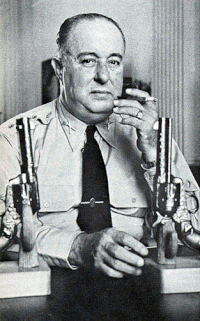| Somoza family Familia Somoza | |
|---|---|
 Anastasio Somoza García, founder of the Somoza family dictatorship | |
| Country | Nicaragua |
| Founded | 1 January 1936 |
| Founder | Anastasio Somoza García |
| Final ruler | Anastasio Somoza Debayle |
| Titles | President of Nicaragua Head of the National Guard |
| Members |
|
| Connected members |
|
| Deposition | 17 July 1979 |
The Somoza family (Spanish: Familia Somoza) is a political family which ruled Nicaragua for forty-three years – from 1936 to 1979. Their family dictatorship, founded by Anastasio Somoza García, was continued by his two sons Luis Somoza Debayle and Anastasio Somoza Debayle.[1] Anastasio Somoza García served as the President of Nicaragua from 1937 until 1956. He was succeeded by his elder son, Luis Somoza Debayle, who held the presidency from 1957 to 1963. The younger Somoza son, Anastasio Somoza Debayle, had two presidential terms: 1967–1972 and 1974–1979. Although the Somozas did not hold the presidency for the full forty-three years, they continued to rule through puppet presidents and via their control of the National Guard.[2][3]
While the Somoza family moved towards modernizing Nicaragua, their rule featured repression and inequality.[3][4] Over four decades, the Somoza family accumulated wealth through corporate bribes, land-grabbing and foreign-aid siphoning.[5] The family received support from the government of the United States, and the leadership styles of each Somoza president was different from one another.[2][6]
Ultimately, the Somoza family was overthrown by the socialist Sandinista National Liberation Front (FSLN) during the Nicaraguan Revolution[7] of 1961–1990. Widespread discontent with the Somoza regime emerged following the Managua earthquake of 1972.[2][4] Anastasio Somoza Debayle declared himself the Head of the National Emergency Committee and used his power to participate in looting and in the mismanagement of international-aid funding.[4] Discomfort increased in the light of the rise of the Sandinista National Liberation Front and in response to the Somoza government's human-rights violations.[3][4] Various opposition groups emerged, and two key approaches to overthrow the dictatorship became clear. While the Broad Opposition Front (Spanish: Frente Amplio Opositor, FAO) attempted to reach a solution via negotiation, the FSLN pushed insurrection.[4] When negotiations failed, the insurrection movement, with military support from the Soviet Union through Cuba, launched a successful offensive into the cities, with human rights violations committed by the National Guard resulting in the Somoza government's international, political and military isolation.[3] On 17 July 1979, Anastasio Somoza Debayle resigned as President of Nicaragua, marking the end of the Somoza-family dictatorship.[4]
The family accumulated wealth through corporate bribes, industrial monopolies, land grabbing, and foreign aid siphoning.[5] By the 1970s, the family owned around 23 percent of the land in Nicaragua.[2][8] The Somoza's wealth is speculated to have reached approximately $533 million, which amounted to half of Nicaragua's debt and 33 percent of the country's 1979 GDP.[2][9]
Three of the Somoza family members served as President of Nicaragua. They were:
- Anastasio Somoza García "Tacho" (1896–1956; President 1937–1947, 1950–1956), the father.
- Luis Somoza Debayle (1922–1967, President 1956–1963), his eldest legitimate son.
- Anastasio Somoza Debayle "Tachito" (1925–1980, President 1967–1972, 1974–1979), his second legitimate son.
Other members of the Somoza family include:
- José R. Somoza, the half-brother of Anastasio Somoza Debayle
- Hope Portocarrero, the wife of Anastasio Somoza Debayle
- Lillian Somoza de Sevilla Sacasa, the daughter of Anastasio Somoza García
- Isabel Urcuyo (1924–2014), the wife of Luis Somoza Debayle[10]
- Anastasio Somoza Portocarrero, a son of Anastasio Somoza Debayle and his wife
- Carolina Somoza Portocarrero, a daughter of Anastasio Somoza Debayle and his wife, who is married to James Minskoff Sterling, son of New York real estate developer Henry H. Minskoff
- Martha Debayle, a niece of Anastasio Somoza Debayle, Nicaraguan Mexican radio hostess and entrepreneur
- Anastasia Somoza, American disability rights advocate and granddaughter of Luis Somoza Debayle
- ^ Vilas, Carlos M. (May 1992). "Family Affairs: Class, Lineage and Politics in Contemporary Nicaragua". Journal of Latin American Studies. 24 (2): 309–341. doi:10.1017/s0022216x00023403. ISSN 0022-216X. S2CID 142988176.
- ^ a b c d e Cite error: The named reference
:2was invoked but never defined (see the help page). - ^ a b c d Bulmer-Thomas, Victor (1990). "Nicaragua since 1930". In Bethell, Leslie (ed.). The Cambridge History of Latin America: Volume VII: 1930 to the Present. Cambridge University Press. pp. 317–366. ISBN 9781139055239.
- ^ a b c d e f Cite error: The named reference
:8was invoked but never defined (see the help page). - ^ a b Cite error: The named reference
:0was invoked but never defined (see the help page). - ^ Christian, S. (1987). "Nicaragua and the United States". World Affairs. 149 (4): 177–182.
- ^ Francois, David (2019). Nicaragua, 1961–1990. Volume 1 : the Downfall of the Somosa Dictatorship. Helion & Company, Limited. ISBN 978-1-913118-41-9. OCLC 1101796058.
- ^ Clifford, Staten (2010). The History of Nicaragua. Santa Barbara, CA: ABC-CLIO. p. 77. ISBN 978-0-313-36038-1.
- ^ Birdsall, Nancy; Williamson, John; Deese, Brian (2002). Delivering on Debt Relief: From IMF Gold to a New Aid Architecture. Washington, D.C.: Peterson Institute. pp. 134. ISBN 0881323314.
- ^ "She's Mrs. Santa to the whole city". St. Louis Globe-Democrat. Managua. 25 December 1959. p. 43. Retrieved 21 January 2020 – via Newspapers.com.